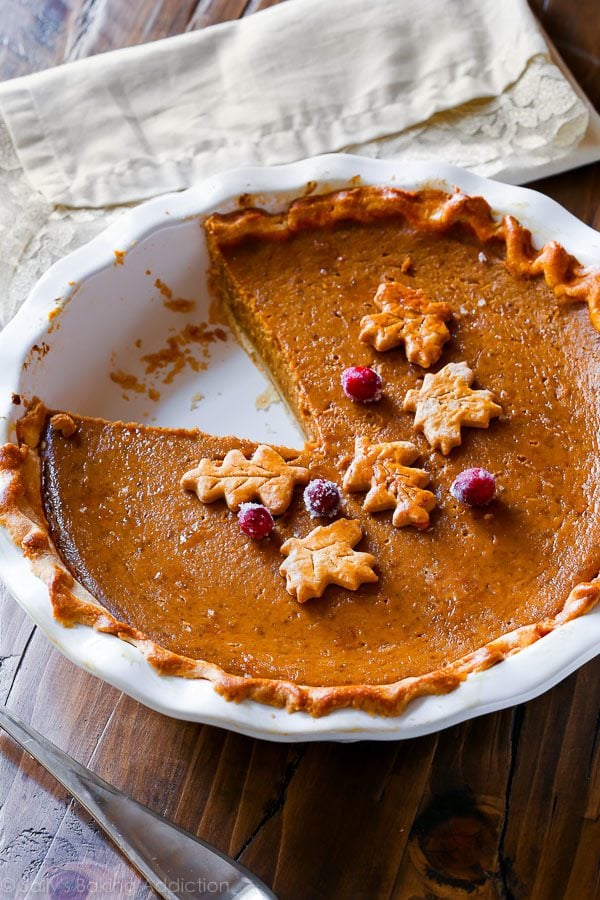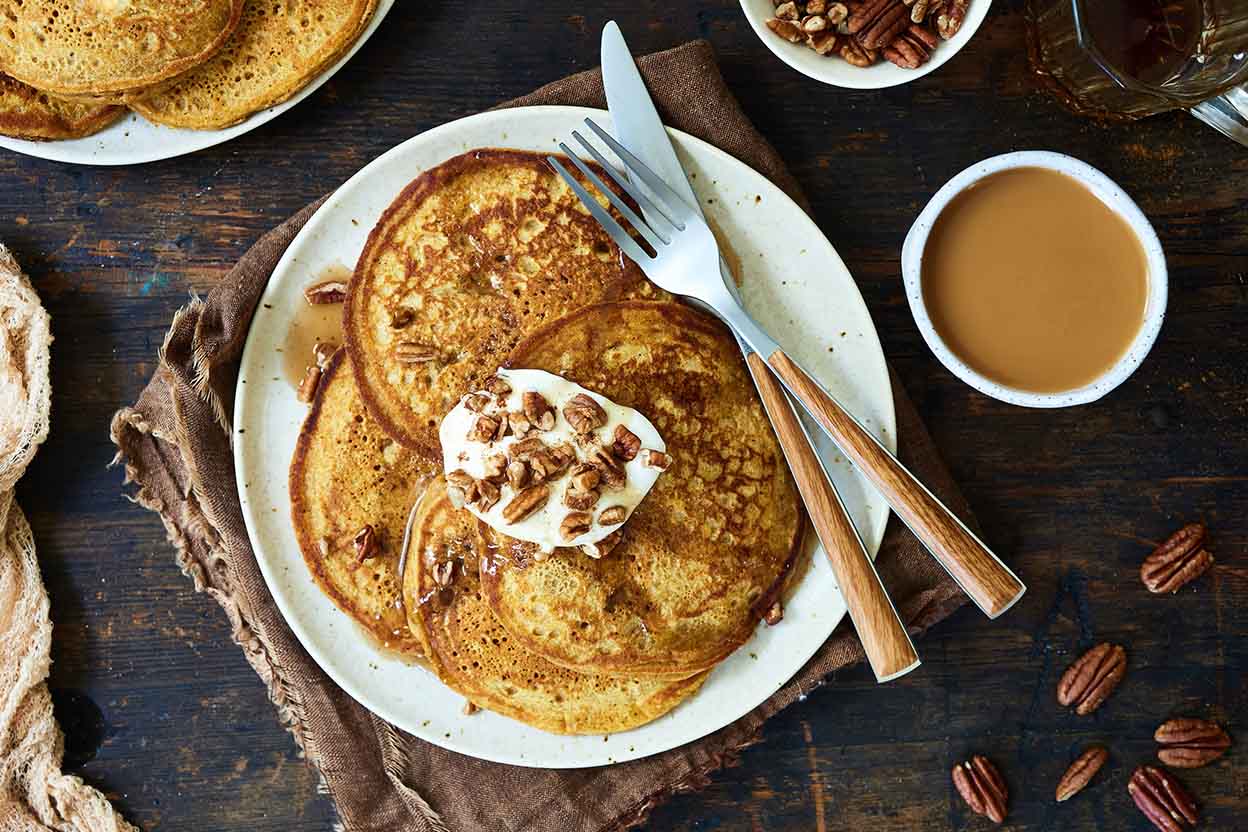- What's Helping Today
- Posts
- Sky Pumpkins
Sky Pumpkins
Sandy's Recipe Club #2

Welcome to What’s Helping Today, a newsletter about the everyday work of staying alive on earth — written by author and journalist Sandy Ernest Allen.
Hi all,
It’s autumnal as heck here in the Catskills, therefore I figured I’d focus my second Sandy’s Recipe Club post on fall and winter squash. Thanks again to all who read my first, long installment of Sandy’s Recipe Club and wrote me lovely words in response.
Thanks especially to those who gave the suggested $5 a month or more — which helps keep my newsletter free for everybody, including these recipes posts. (Folks who give $5 a month or more, feel free to tell me what potential perks you’d most enjoy ... I’m thinking I’ll schedule a group meditation perhaps sometime soon.)
If you can and you’re feeling generous and you want to support my work, again: Please give to my Buy Me a Coffee.
Every bit helps; thank you.
Sky Pumpkins
In previous years I’ve grown other sorts of fall and winter gourds but this year I sowed the few varietals I love cooking with most — delicata, futsu, kabocha, and sugar pumpkin.
I start my gourds inside under lights, around the same time as my tomatoes, ~6 – 8 weeks before my last frost date here (which for us is around June 1). In general, for fall and winter squash to mature in time I recommend you start them as early as you can. When you do transplant out, give the vines somewhere to go, if not vertically, horizontally where they won’t be trampled. Also make sure your beds are amended with compost.
After previous years with less success, I gave my fall and winter gourds this year a prominent placement on my biggest arch. This eventually yielded to my delight: Sky pumpkins (as I came to call them).
Here the sky pumpkins were in September …
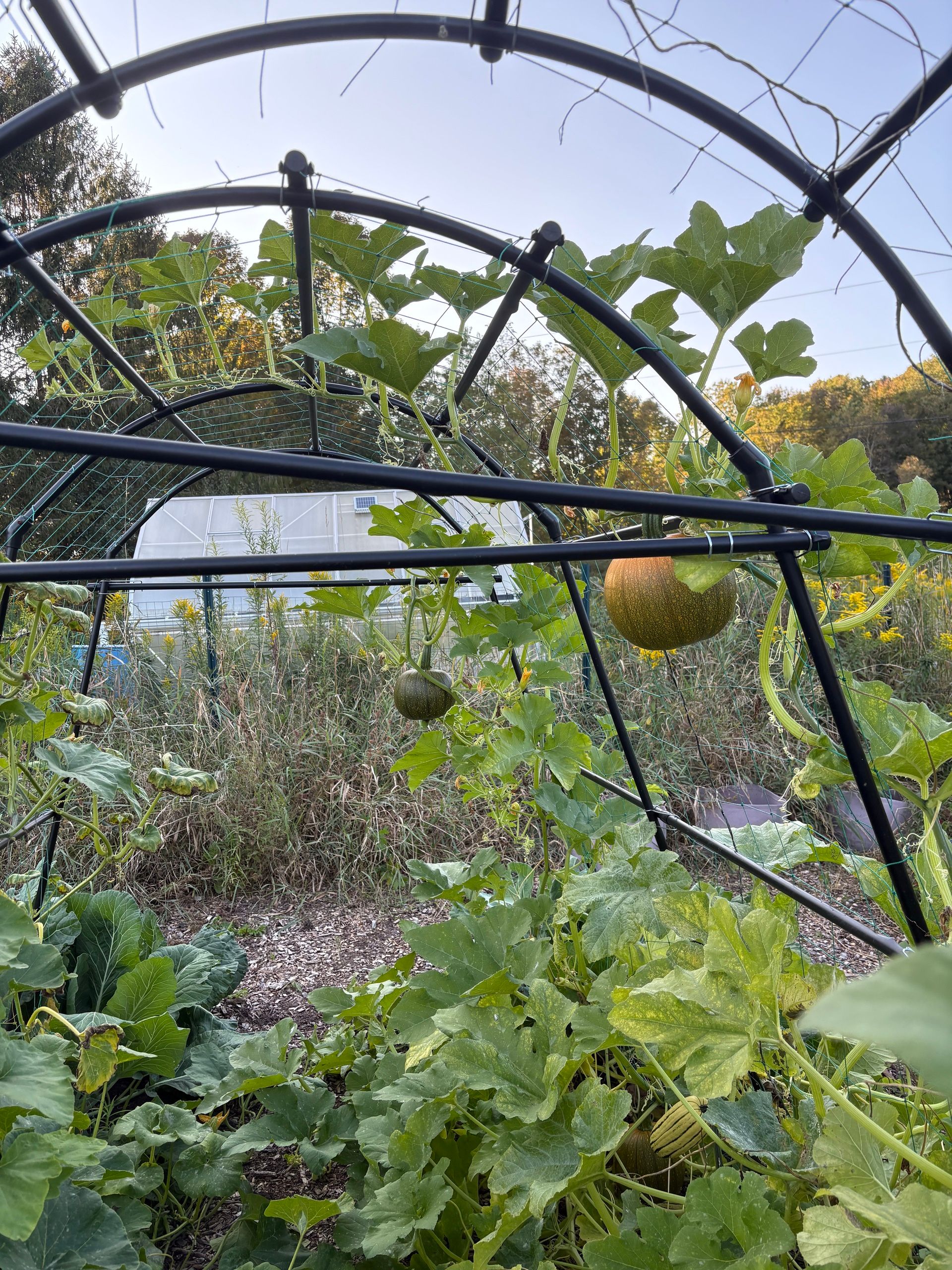
Here they were a month later in early October …

And here they were when I harvested them with a friend who was visiting:
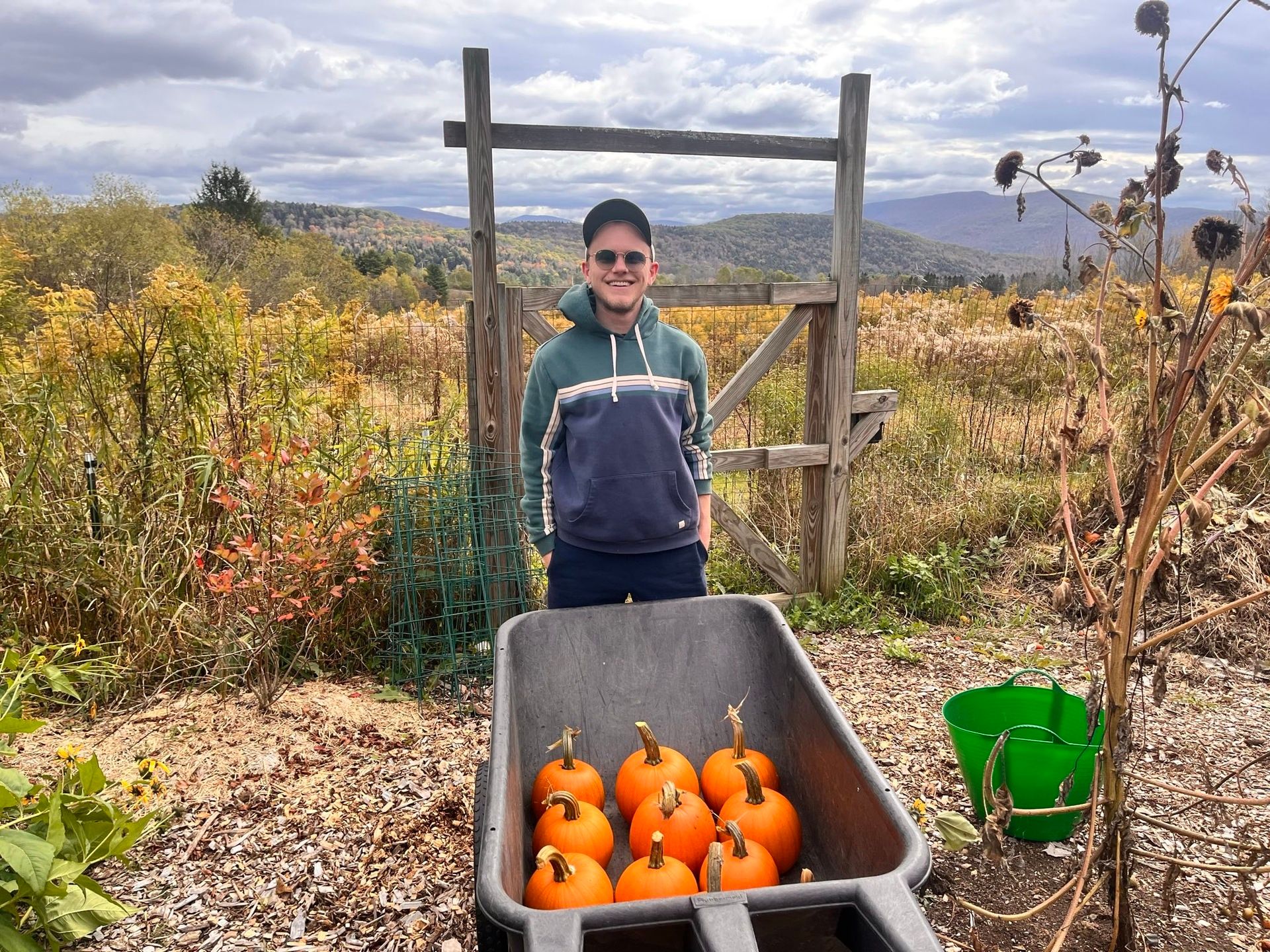
What a haul!
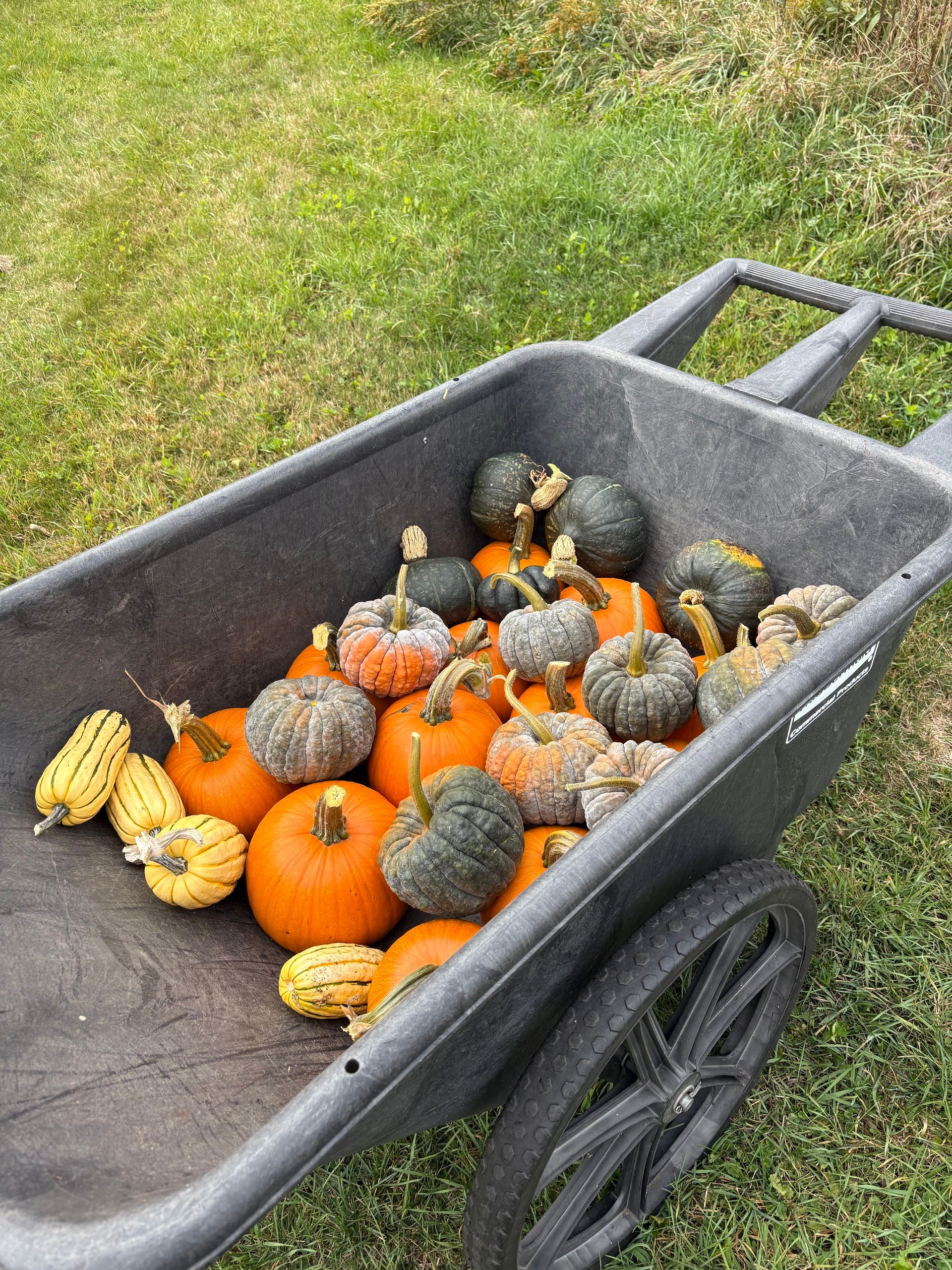
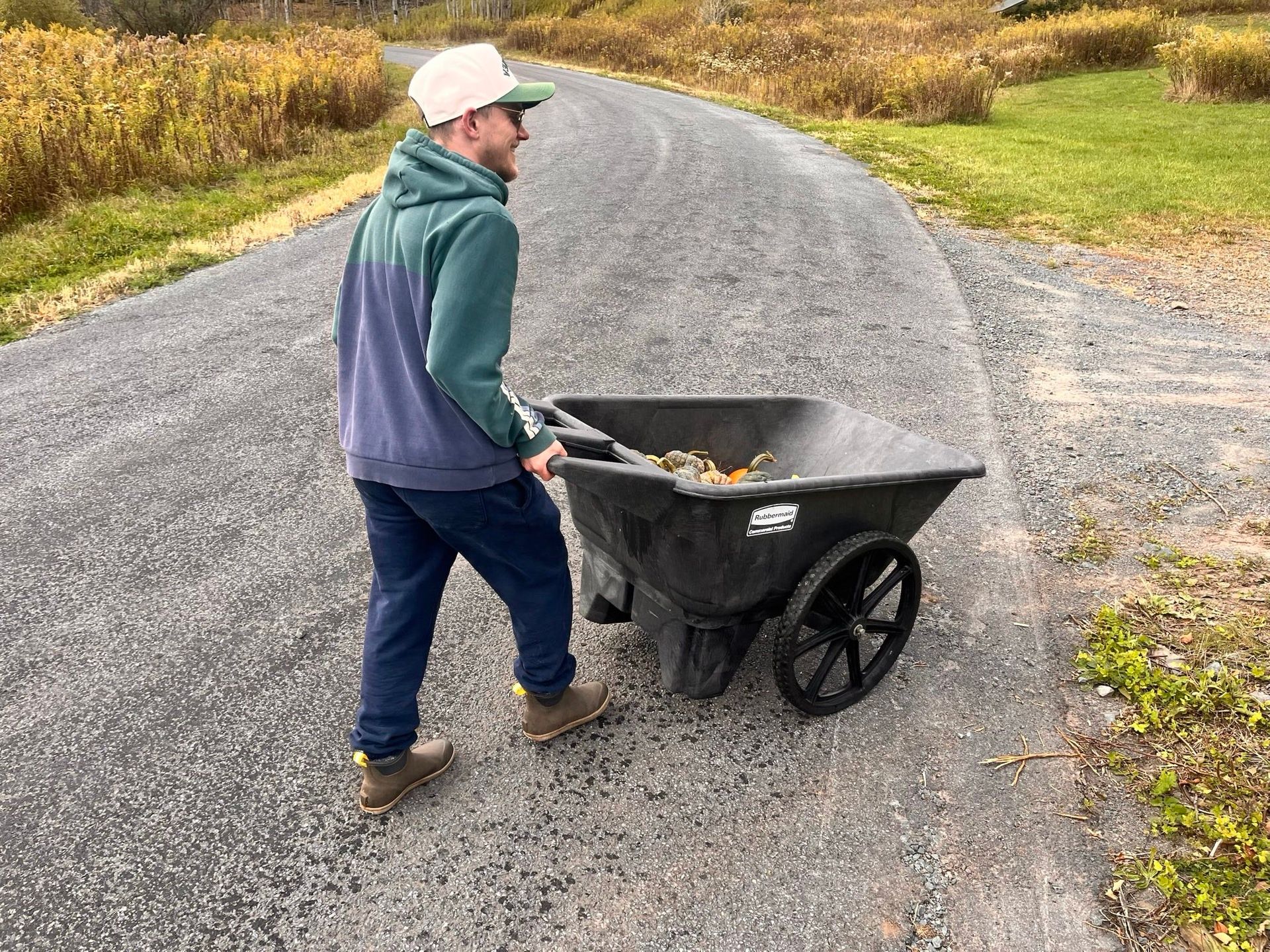
Once harvested, I then let them cure on my sunny, southern-facing front porch. Here they get great light but they don’t get eaten by various critters or destroyed by a hard frost or an early snow … (As I once learned the worst way when I lost my entire crop.)
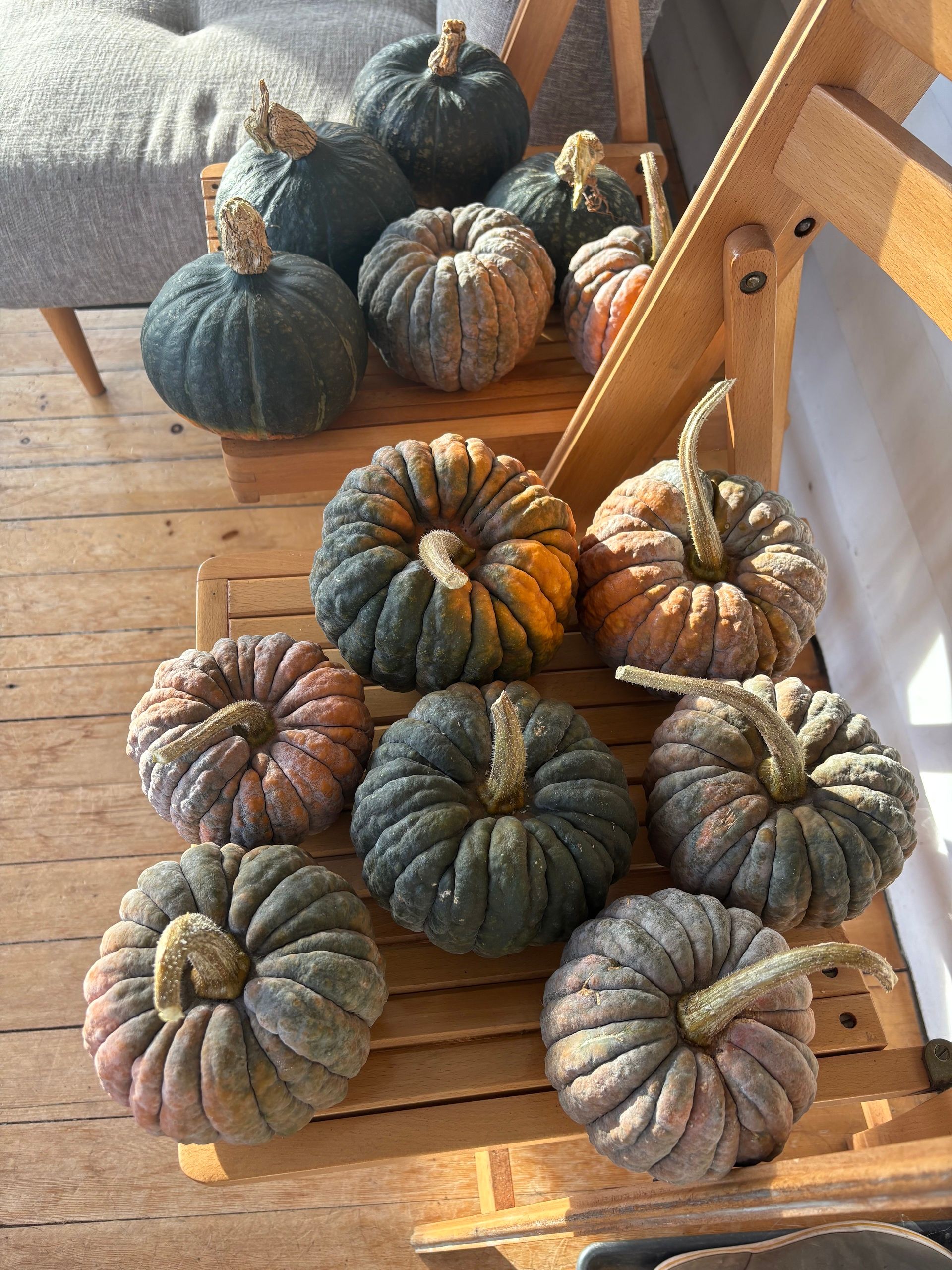
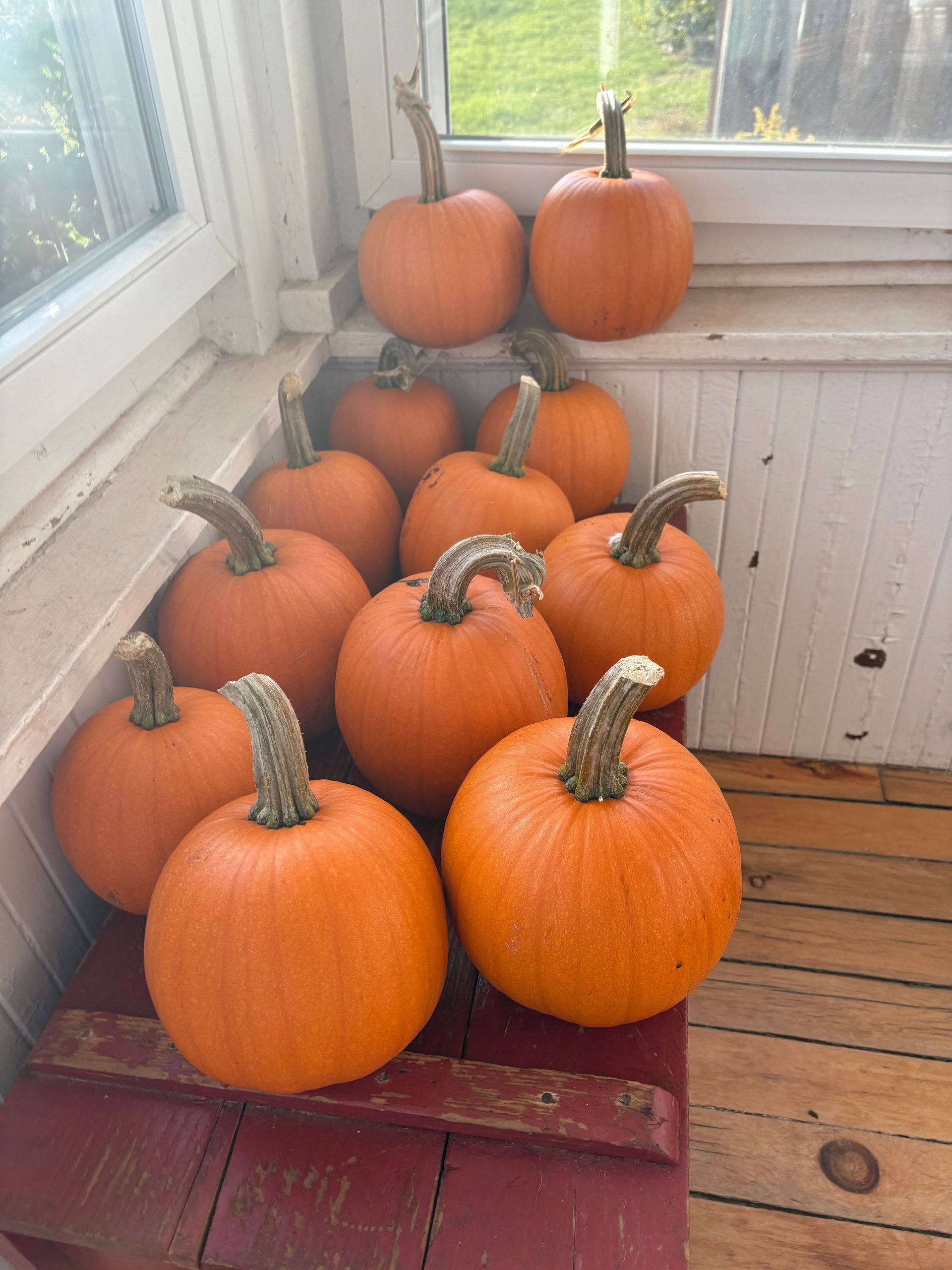
I’ve been texting local friends and neighbors, offering them sugar pumpkins especially, because this is way more than I’ll be able to deal with. A few have already taken me up on this, which makes for a nice brief visit — a hello and gourd exchange if not conversation and cup of coffee. (I do adore the rural, exchange economy vibe.)
Gourds are ready for basement storage once they’ve fully cured (the stems for example will look brown, not green). Note: Never carry gourds by their stems because the stems might break off and keeping the stem on helps winter gourds last longer in storage. In other words, if any stems do break off, eat those ones first …
A former professional cook friend of mine who read this draft asked why gourds have to cure first. My sense is gourds cure in sunlight, dry, before going into the dark (and also ideally dry) basement mostly to discourage mold. Various other homegrown produce I also cure before storing (methods vary depending on what), as with for example potatoes, onions, or garlic.
Here are some fall and winter gourd-focused recipes, from me and others …
Sugar Pumpkin Roasting 101
Sugar pumpkins are smaller than the larger pumpkins sold for carving (which I’ve also grown before, and is also fun to do but in more of an arts and crafts sense). To roast a sugar pumpkin or any other hard fall or winter gourd of this sort:
I first pop off the stem, then I very carefully saw the pumpkin in half, long-ways, using a serrated knife. Using a big metal spoon, I clean out the cavity, scooping out all the pulp and seeds (see below for more).
I roast the two halves, face down, on a parchment-lined baking sheet until done. Depending on the given gourd’s size this can take 30 minutes to 45 or more. You’ll know a pumpkin’s done roasting when the flesh is soft (you can turn one over to check, perhaps testing with a fork), and the pumpkin’s leaking liquid, losing its shape, even starting to caramelize. Your kitchen will probably also smell divine.
I let the pumpkins cool some, then I scrape the flesh into a food processor and run until smooth. Then you can fridge the pumpkin (if you’re going to use within the next few days) or otherwise freeze for future use, leaving some head room in your container.
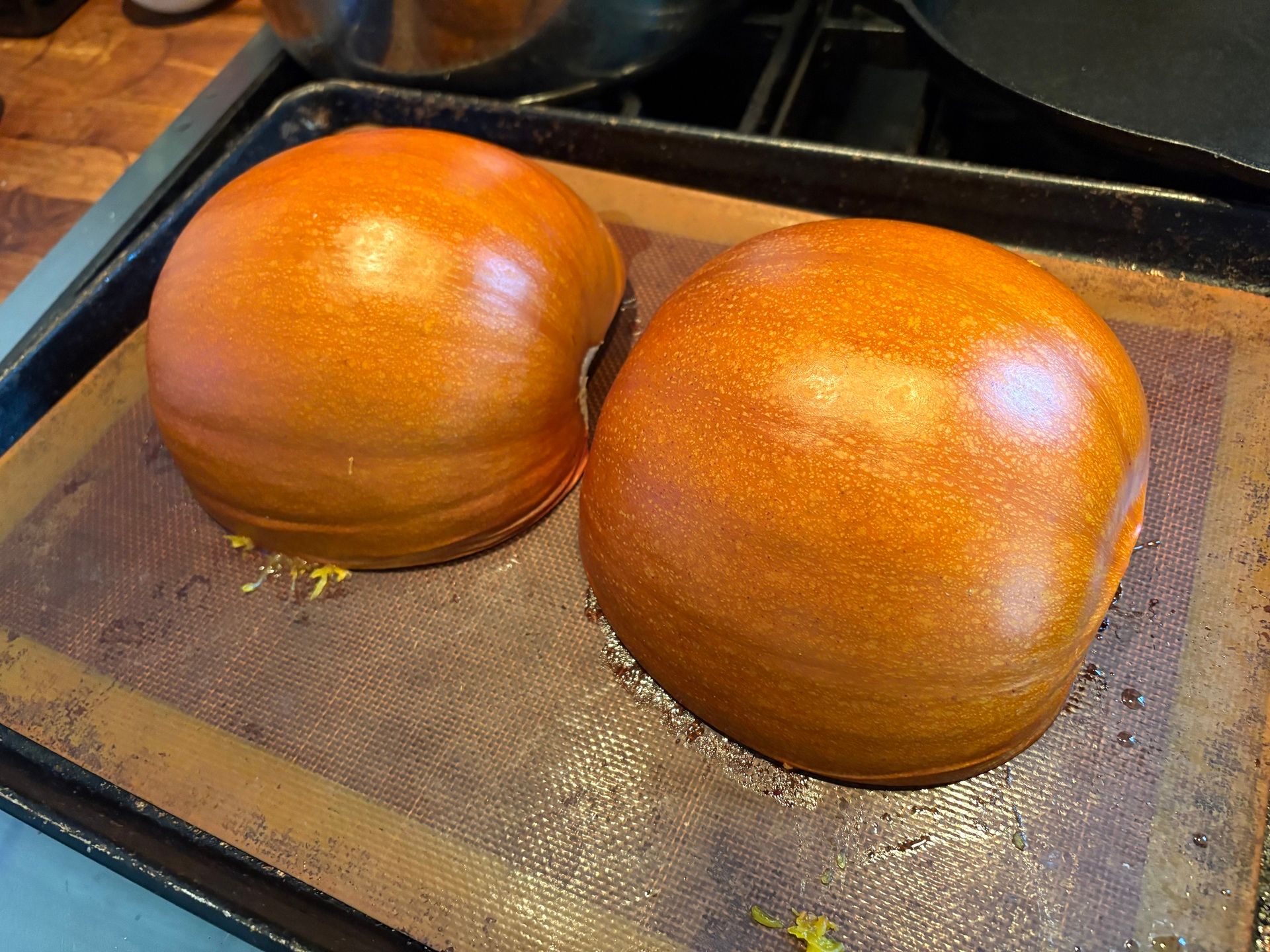
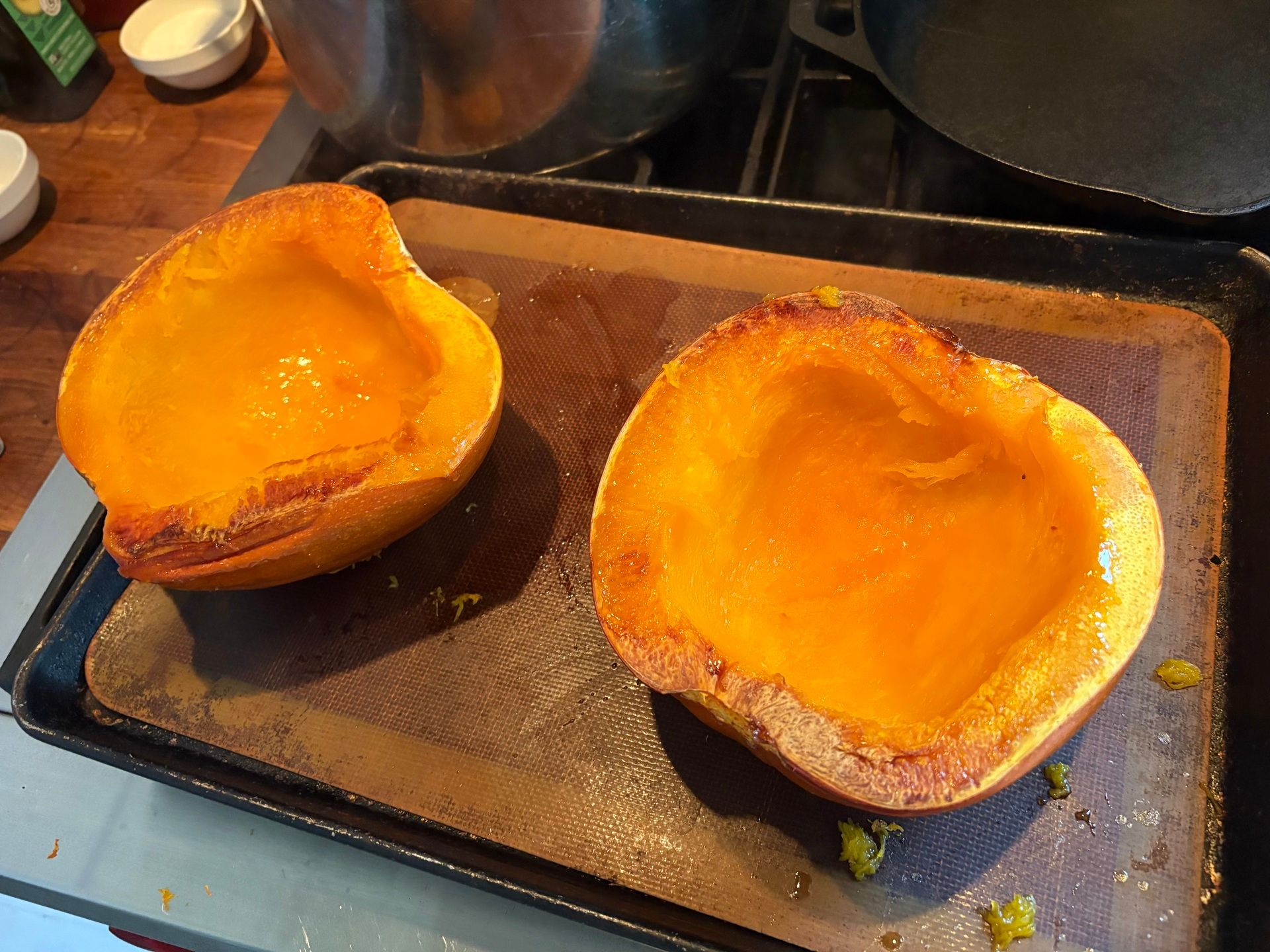
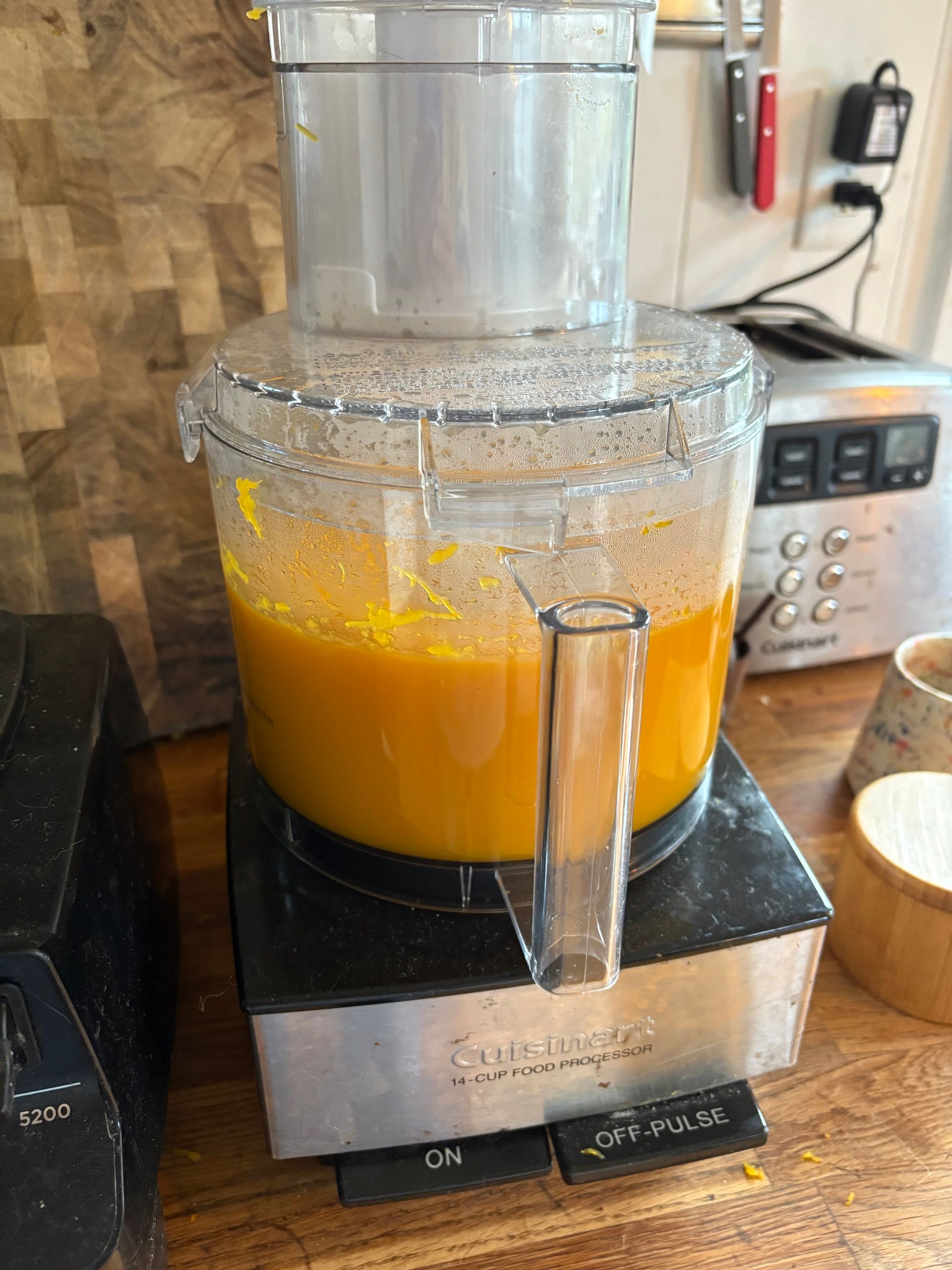
Roasted Pumpkin Seeds
Nothing too original here but sharing in case: To roast pumpkin seeds … I recommend first of all, keeping a medium-sized bowl of cold water nearby as you’re carving your pumpkin to plop your pumpkin pulp-and-seeds into. Then run your fingers through the mess in the water to separate the seeds from the rest. This activity will be tedious and slimy. Skim the seeds off and put them on a tray on a kitchen towel to dry in open air.
Tip: Do not use paper towels!!! The seeds will stick and it renders them unusable in my learned-the-hard-way experience.
Let the seeds dry out for a few days at least … and then: Toss them with EVOO and salt (and whichever spices or other seasonings you like). Roast them on a cookie sheet in the oven until toasted at ~375. Watch them though and occasionally carefully mix them around with a spatula so they don’t burn. The seeds are ready when they’re mostly browned and taste amazing. You can toss with more salt and spices as you feel is needed. (I like za’atar pumpkin seeds best.) Let them cool some, if you can stand the wait, before consuming them and allowing others do the same …
Note: I have found that other winter squash have seeds that don’t tend to taste very good once roasted. Sugar pumpkin seeds are my personal favorite though you can also use the seeds from larger, carving-type pumpkins.
Delicata Pesto Pasta
This recipe is such a mainstay around here I don’t remember where it’s even adapted from …
First, roast a few delicata squash. Prepare by removing stem, carefully cutting long-ways in half, then scooping out the insides until clean. Delicata do not need to be peeled, which is one reason they are the fucking best … That and they are so delish.
I slice them into half-moons (like a quarter inch thick) and toss them with evoo and salt. I roast on a baking sheet at 350 until caramelized, flipping about halfway through. Keep an eye on them and move them around so they don’t burn.
Meanwhile: Cook whichever pasta you’re using. I like orecchiette for this or farfalle or radiatori — but really whatever’s fine. Add whichever pesto you like (can be store-bought) and then the roasted delicata. Heat up until hot but not much beyond (especially if your pesto’s basil). Super simple.
In this house, we’re devotees of Samin Nosrat’s pesto methods (as described herein). A favorite pesto type to pair with roasted delicata is kale-and-walnut. You can of course do a more traditional basil-and-pinenut for example. We also often have frozen pesto from the spring and summer in the basement freezer; even sharper pestos like radish top or garlic scape do marry well with this super sweet roasted squash.
Pumpkin Smoothie
I made this up the other day and my taste tester raved that if I sold this in Manhattan everybody would line up to buy one. I indeed had had the same thought …
Sugar pumpkin, roasted and pureed (a cup and a half or more). I used pumpkin puree that was partially frozen (you can substitute canned pumpkin; depending on the brand it just may impact flavor).
One frozen banana (for thickening; you can also use chia seeds I bet as long as something else in the smoothie is frozen, like you could even add some ice too)
Oat milk (enough to blend until smooth)
Agave (as needed, depending on sweetness of pumpkin/banana)
A few dashes of nutmeg
Blend it all up and dang, SO tasty.
ICYMI, I shared more smoothie recipes (and wrote about why I’m into smoothies) in my last Recipes Club installment.
Winter Squash Chili
I also like cubing and roasting winter squash and adding it to chili, as I did with this gorgeous kabocha squash the other day …
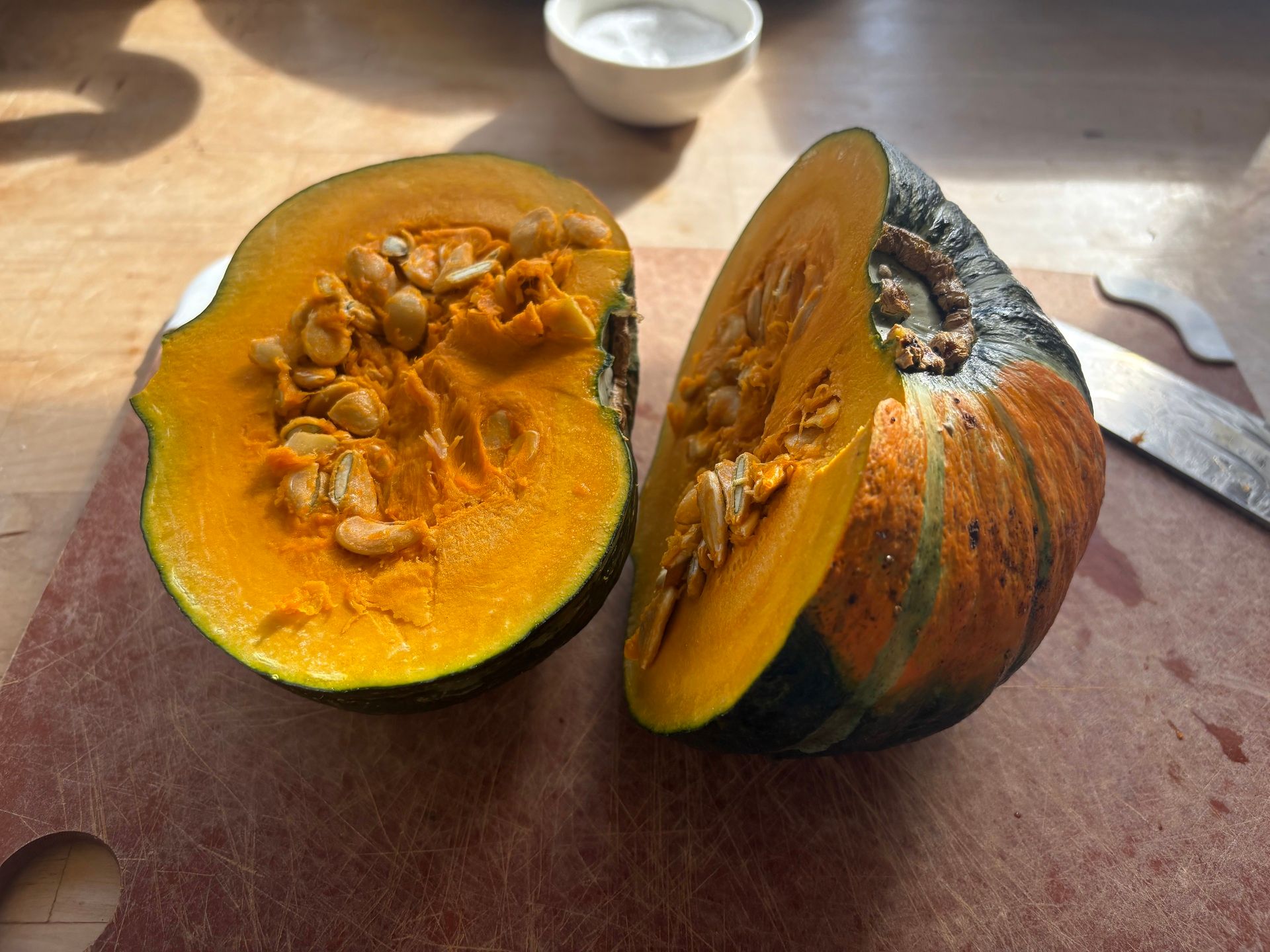
I peeled the squash with a vegetable peeler (which is sorta challenging and mostly requires commitment; it felt like I was peeling a basketball). I then cubed the squash (into about 1” - 2” pieces) and tossed with EVOO and salt, roasted on a parchment-lined baking sheet at 350 … and then added to my nearly-finished chili. You may want to see the last post for more on how I cook beans, my approach to chili being more or less the same …
For this kabocha chili, I’d started with a diced onion and the final poblano peppers of my season, and then some minced garlic. I used three sorts of beans (pinto, white, kidney). When I added the roasted squash towards the end, I also added some frozen defrosted homegrown tomato puree (described last time as well).
I wound up with a huge pot of chili, most of which I froze … I serve chili with various not-too-original toppings such as: Fresh chives or scallions or cilantro, and/or avocado (depending on what I have or what’s in season), cheddar cheese, sour cream, Frito-style chips (I like these). Or I love chili in a sourdough bread bowl, Bay Area guy that I am …
This BTW is my personal favorite cornbread recipe (for a sweeter, cake-ier style) … and/or this buttermilk skillet cornbread (recipe via the Wayback machine), which has been made around here approximately one trillion times …
Just to share a few more recipes that aren’t mine but I do rely on …
Winter Squash Pie
This is the very best pumpkin pie recipe in existence, IMO … because it doesn’t use any bullshit ingredients (unlike 99% of other pumpkin pie recipes for some reason). I’m very faithful to it in part because it’s just so delicious …
“My” pumpkin pie tends to be the above filling with instead the following crust (which is my go-to):
Pumpkin Pancakes
I prefer King Arthur’s pumpkin pancake recipe over all the others I’ve tried. I made them just the other day and they were great … These — like any pancakes — can be frozen and quickly reheated in the toaster (using the defrost setting if you have one) or a low oven, like 250.
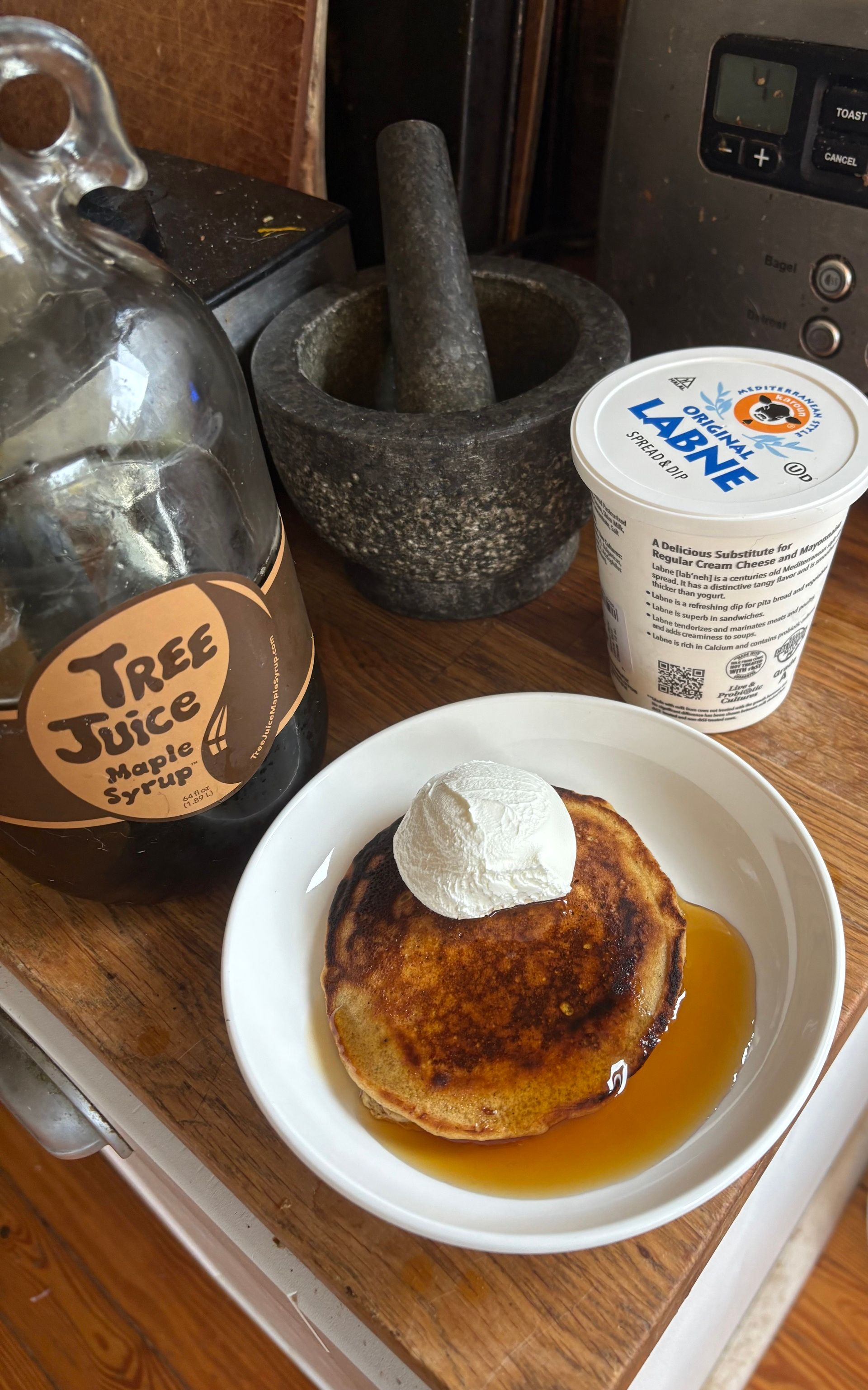
I like to top with syrup and yogurt (or labne, as above).
This might be obvious to some readers but just to say in case: I’ve easily made (pumpkin) pancakes egg free or dairy free or vegan in the past, by substituting oat milk and/or Bob’s Egg Replacer and/or coconut oil for butter. All-vegan pumpkin pancakes I do like; they tend to feel lighter.
When baking, I prefer this oat milk over other dairy-free milk options if only because it lacks additional sugar. Note: If your preferred dairy-free milk has any added sugar, consider cutting your given recipe’s sugar accordingly.
Feel free to write to tell me: What are your favorite ways to cook or bake with fall and winter squash? (Beyond other perhaps obvious ideas like roasting squash for grain bowls or salads; pumpkin bread and muffins; or squash soup.) I do typically make and freeze much squash soup but this year noticed it was the last soup we seemed to actually consume, which made me think it’s time for a squash soup hiatus …
If you try any of my recipes above and you want to let me know how it goes (or you want to send pics), that would delight me! Your feedback is always welcomed. As are any questions, related to food or cooking, which maybe I’ll answer in a future Recipes Club post …
Gourd luck,
Sandy
p.s. As I’ve composed this food-related post, my heart has felt heavy knowing that right now millions of people are facing imminent loss of SNAP benefits — amongst other GOP-induced horrors. I plan on donating to my local community pantry this week (as I have in the past and as I’ll probably write about more in a future post). Point being: If you can, I hope you will consider doing the same for those in your area … Some people I follow on Bluesky have even said they’re matching donations …
Following Ada's lead, I'd like to do the same. Reply to me w/ a receipt of a donation to a food bank of your choice, and I'll also match your donations, up to $500. 🍎🍌🥬🍞🥩❤️
— Celeste Ng (@pronounced-ing.bsky.social)2025-10-25T13:43:29.169Z
p.p.s. Another good idea I’ve seen going around, for anyone this applies to …
if you want to defend the working class? buy out a street vendor’s cart so they don’t have to choose between their income or kidnapping by ICE
— Melissa Gira Grant (@melissagiragrant.com)2025-10-25T13:01:38.223Z
Thanks for reading What’s Helping Today, a newsletter by me — author and journalist Sandy Ernest Allen. If you were forwarded this message, this newsletter is free; you can subscribe here.
